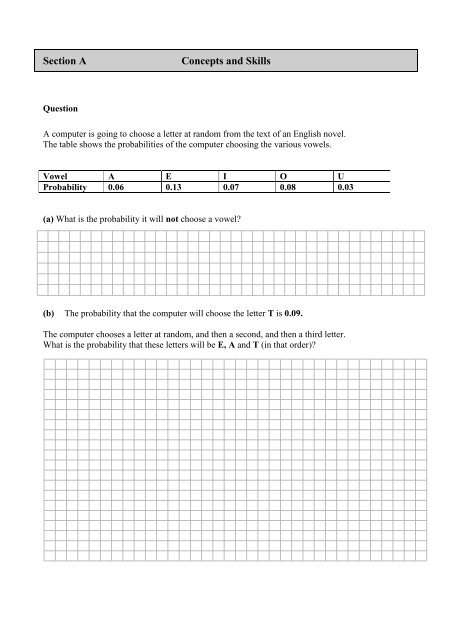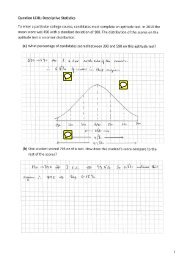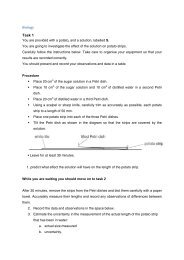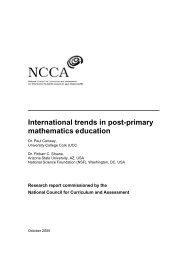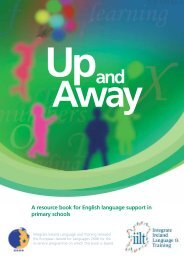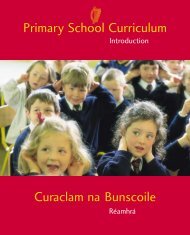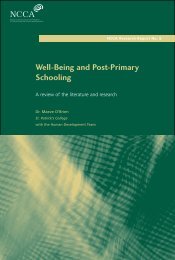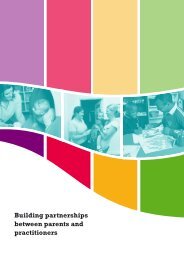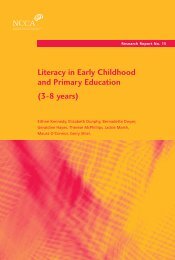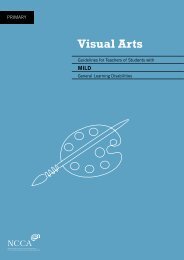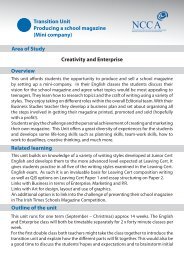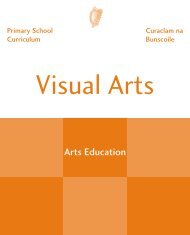Ordinary Level
Ordinary Level
Ordinary Level
Create successful ePaper yourself
Turn your PDF publications into a flip-book with our unique Google optimized e-Paper software.
Section A Concepts and Skills<br />
Question<br />
A computer is going to choose a letter at random from the text of an English novel.<br />
The table shows the probabilities of the computer choosing the various vowels.<br />
Vowel A E I O U<br />
Probability 0.06 0.13 0.07 0.08 0.03<br />
(a) What is the probability it will not choose a vowel?<br />
(b) The probability that the computer will choose the letter T is 0.09.<br />
The computer chooses a letter at random, and then a second, and then a third letter.<br />
What is the probability that these letters will be E, A and T (in that order)?
(c) How many ways can these three letters be arranged? Show each arrangement.<br />
Question<br />
(a) The diagram shows two touching circles; c1 and c2. Using the diagram to estimate the centres<br />
and radii as accurately as you can, find the equations of the two circles.
(b) It is claimed that the line with equation x – y + 6 = 0 is a tangent to both circles.<br />
By performing suitable calculations, decide whether this claim is true or false.<br />
Explain your answer.
Question<br />
In this diagram state whether each of<br />
the following statements is true or false<br />
(by placing a in the appropriate<br />
box) and in each case give a reason for<br />
your answer.<br />
a) k m<br />
True False<br />
b) area GIJ = 32 sq. units<br />
True False<br />
2<br />
c) the equation of k is y x 6<br />
3<br />
True False<br />
d) m n<br />
True False
e) the line y 2x 1 is perpendicular to n<br />
True False<br />
f) the line y 2 x is parallel to m<br />
True False<br />
g) GIJ is an isosceles triangle<br />
True False<br />
h) the x-axis is the bisector of GIJ<br />
True False
Question<br />
Sophie and Amy were designing a game of chance to raise money for charity in their school.<br />
They agreed on the following:<br />
they would call the game Spin and Win<br />
they would charge 50 cent to play<br />
the rule would be: roll a six-sided die and spin the spinner shown and add the totals.<br />
However, they each had different ideas about which outcomes would result in a win, a loss or the<br />
player getting their money back.<br />
Sophie’s Idea Amy’s Idea<br />
Money back: Get total of 13 Money back: Even number total<br />
Win €1: Even number total Win €1: Odd total, but not prime<br />
Lose: Anything else Lose: Anything else<br />
(a) By calculating the expected value of the profit or loss for each idea, write an argument to<br />
support either Sophie or Amy’s idea.
Without changing the rules, give your own idea for win, lose and money back that would generate<br />
more money for the charity. Justify your idea.
Question<br />
Construct an equilateral triangle. Prove that the inscribed circle and the circumcircle have the same<br />
centre.
Question<br />
(a) The diagram shows a rhombus (that is, a parallelogram with four sides of equal length). The<br />
midpoints of two of its sides are joined with a straight line segment.<br />
Calculate the size of angle A. Show how you found your answer.
(b)<br />
Find the value of a. Show how you found your answer.<br />
GIJ
Question<br />
Sarah is on a TV game show called Take the Money and Run.<br />
She has won €10,000 so far. She now has four options:<br />
Option 1: Leave the show with €10,000 – that is, Take the Money and Run<br />
Option 2: Play on and take a 50% chance of winning €50,000<br />
Option 3: Play on and take a 30% chance of winning €75,000<br />
Option 4: Play on and take a 20% chance of winning €100,000<br />
If she plays on, and does not win the higher amount she loses the €10,000.<br />
(a) Calculate the Expected Value of Sarah’s winnings for each of the four options.<br />
(b) What would you advise Sarah to do and why?
Question<br />
The ray method was used to enlarge a design for a Valentine card. The original is labelled A and the<br />
image is labelled B.<br />
(a) Find the centre of the enlargement.<br />
(b) Find the scale factor of the enlargement. Show your work.<br />
(c) Calculate the ratio . Give your answer correct to one decimal place.
Question<br />
Two spinners, each with four equal segments numbered 1 to 4, are spun.<br />
(a) Using a list, table, tree diagram, or otherwise, show all the possible outcomes.<br />
(b) If the spinners are fair, what is the probability of getting two fours?<br />
(c) Jason thinks that one of the spinners is not fair.<br />
Describe an experiment that he could do to find out whether the spinner is fair.
Question<br />
Two points A( - 3, 2) and B( 4, - 1) are shown on the diagram below. Plot two suitable points C and<br />
D so that ABCD is a parallelogram. Label the points and write down their coordinates.<br />
(b) By performing suitable calculations, show that the figure you have drawn is indeed a<br />
parallelogram.<br />
(c) Verify that the diagonals of the parallelogram bisect each other.
Question<br />
(a)On the diagram below, show the triangle ABC, where A is ( -4, 1) B is ( -2, 5) and C is (6, 1)<br />
(b) Find D, the midpoint of [AC], and label this point on the diagram.<br />
(c)Hence, construct on the diagram the circle with diameter [AC].<br />
(d) Show that the angle is a right angle.
Section B Contexts and Applications<br />
Question<br />
(a)The modern or Olympic hammer throw is an athletic throwing event where the object is to throw<br />
a heavy metal ball attached to a wire and handle. In the diagram below A2 represents a portion of the<br />
throwing circle and A1 represents the area in which the hammer should land. The diagram is not<br />
drawn to scale.<br />
(i) A net is to be erected at the end of the landing area. The foundation consists of a single row of<br />
bricks; each brick is 41cm long. How many bricks will be needed to lay the foundations?<br />
(ii) The area A1 will be planted with grass. A 10kg bag of lawn seed covers approximately 220m 2 . How<br />
many bags of grass seed must be bought?<br />
Show all your work and state any assumptions you make.
Question<br />
The lengths of the ring fingers of 30 Irish students chosen randomly from amongst those who<br />
completed the censusatschool phase 9 questionnaire are displayed below. The measurements are in<br />
cm.<br />
7.5 8 7 6 7.5<br />
8.3 6.5 8 5 9<br />
7.3 8.5 7 7 9<br />
7.2 6.5 7 10 9<br />
3 4 6.6 6 8<br />
7 8 7 7.5 8.4<br />
(a) Use the data to investigate whether ring finger lengths are normally distributed. Explain your<br />
answer.
(b) Sharon measured the length of her ring finger and found it to be 11.3cm. Her boyfriend says<br />
her finger length is most unusual; Sharon disagrees. By calculating the mean and standard<br />
deviation of the distribution above, present evidence to support either Sharon’s argument, or<br />
that of her boyfriend.
Question<br />
(a) A teacher asked the students in her class to estimate the height of the church opposite the<br />
school in metres.<br />
The stem-and-leaf diagram shows all the results<br />
Key: 3 5 represents 35m<br />
3 5 9<br />
4 0 2 6 8 8<br />
5 3 3 5 7 7 9<br />
6 0 5 5 5<br />
7 4 8<br />
8 2 7<br />
(i) How many students are in the class?___________<br />
(ii) Describe the shape of the distribution of the data<br />
(iii) What was the median estimate? ____________<br />
(iv) Explain the answer to part (iii) to someone who does not know what the word “median” means.
(b) Alex and Bobby are running in the final of a 100m race and a 200m race.<br />
The probabilities of each of them winning each race are given in the table below.<br />
The probability that neither of them wins the 100m race is also given.<br />
100 metre race<br />
200 metre race<br />
Alex Bobby Neither<br />
(i) Complete the table above, by inserting the probability that someone other than Alex or Bobby<br />
wins the 200 metre race.<br />
(ii) Using the tree diagram or otherwise, complete the list of outcomes below. For example, the<br />
outcome that Alex wins the first race and the second race is recorded as (A, A) as shown.<br />
(c) What is the probability that Alex and Bobby win a race each?
Question<br />
The students mentioned in (a) above went to measure the height of the church.<br />
(a) Peter explained his group’s method:<br />
“We made a clinometer from a protractor, a pen tube,<br />
some thread and a weight.<br />
We measured the distance from here to the church and<br />
it was 92 metres.<br />
We made sure the ground was flat,then we used the<br />
clinometer to look up at the top of the spire of the<br />
church. The weight had moved from 90 to 65 , so we<br />
knew the angle up was 25 . We worked out the height<br />
from that. But we had to remember to add on my<br />
height of 1.8 metres at the end.”<br />
.<br />
(i) On the diagram below, show the measurements that Peter’s group made.<br />
(ii) Show how Peter’s group used these measurements to find the height of the church.
) Hannah was in a different group from Peter. She explained her group’s method for finding the<br />
height of the church:<br />
“It was really sunny and we used the shadows cast by the sun.<br />
Amy stood with her back to the sun and we used a tape measure to measure Amy’s shadow along<br />
the ground from the tips of her toes to the top of her shadow’s head. We also measured Amy’s<br />
height and recorded the results in the table.<br />
Then we recorded the length of the shadow cast by the church. We measured along the ground from<br />
the base of the church out to the end of its shadow and recorded this measurement.”<br />
Amy’s Shadow 2 m<br />
Church’s Shadow 69.4 m<br />
Amy’s Height 1.7 m<br />
Show how Hannah’s group used their results to calculate the height of the church.<br />
(c)The church is actually 50 metres high. Calculate the percentage error in each groups result.
Question<br />
Oxygen levels in a polluted river were measured at randomly selected locations before and after a<br />
clean-up. These results were given in the table:<br />
20<br />
23<br />
2<br />
(a) Construct a back-to-back stem-and-leaf plot of the above data.<br />
(b) State one difference and one similarity between the distributions of the measurements before<br />
and after cleanup.<br />
Difference:<br />
Similarity:<br />
Before (mg/l) After (mg/l)<br />
25<br />
23<br />
10<br />
20<br />
10<br />
11<br />
9<br />
11<br />
5<br />
11<br />
26<br />
11<br />
3<br />
10<br />
15<br />
8<br />
10<br />
11<br />
11<br />
9<br />
11<br />
4<br />
13
Question<br />
Noel and Sarah were taking part in a mathematics competition with other students from the<br />
ProjectMaths schools. They were finding the area of the face of the triangular sculpture shown<br />
below.<br />
Noel said: “We should measure the height and base of the triangle. Then use the formula that says<br />
the area is half the base by the height.”<br />
Sarah said: “Okay. How do we know which side is the base?”<br />
Noel said: “it doesn’t matter, because of the theorem we did.”<br />
(i) State the theorem that Noel is talking about.
(ii) Noel and Sarah trace the triangle on the photograph onto a page to find it’s area. Their drawing<br />
is shown here. By making suitable measurements on the drawing, verify the theorem you stated<br />
in part (a).<br />
(c) Suppose that the drawing was a true representation of the face of the sculpture. If each<br />
centimetre in the drawing represents 70cm in reality find the area of the face of the sculpture.<br />
(d) The true shape of the face of the sculpture is shown below. The people who made it have<br />
changed their mind and now want a parallelogram instead!<br />
Show how the triangle could be turned into a parallelogram by making one cut and moving one of<br />
the two pieces. You should make it clear exactly where the cut is to be made, and show the new<br />
position of the piece moved.


